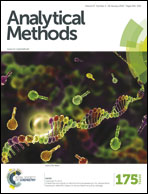Aminocalix[4]arene monolayers as magnetoelastic sensor sensing elements for selective detection of benzo[a]pyrene
Abstract
A wireless magnetoelastic-sensing device for the selective detection of benzo[a]pyrene (BaP) is reported using aminocalix[4]arene (AC4) monolayers as the sensor sensing elements and AC4-modified Au nanoparticles (AC4-Au NPs) as signal-amplifying tags. A sandwich-type detection strategy involves the AC4 self-assembled on the Au-protected sensor surface and AC4-Au NPs, both of which flank the BaP target in sequence. As the AC4-Au NPs combined BaP absorbs on the sensor's surface, there is an increase in the mass load on the sensor, and consequently a decrease in resonance frequency. Under optimal conditions, the sensor shows a linear response to the concentration of BaP in the range of 1.04 × 10−7 M to 1.04 × 10−11 M, with a detection limit of 5.0 × 10−11 M. Other polycyclic aromatic hydrocarbons (PAHs) and environmental pollutants show no interference on the detection.
![Graphical abstract: Aminocalix[4]arene monolayers as magnetoelastic sensor sensing elements for selective detection of benzo[a]pyrene](/en/Image/Get?imageInfo.ImageType=GA&imageInfo.ImageIdentifier.ManuscriptID=C5AY02540K&imageInfo.ImageIdentifier.Year=2016)

 Please wait while we load your content...
Please wait while we load your content...